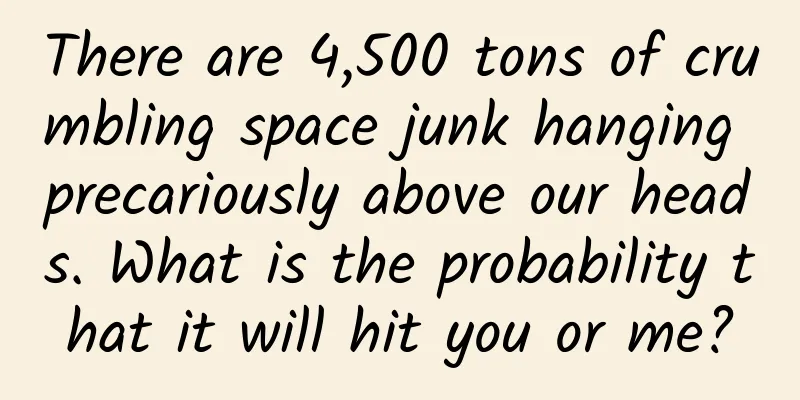There are 4,500 tons of crumbling space junk hanging precariously above our heads. What is the probability that it will hit you or me?

|
On the afternoon of December 30, 2024, as people all over the world were celebrating the New Year with joy, a ring-shaped glowing metal with a diameter of more than 2.4 meters and a weight of more than one ton fell from the sky and landed directly in a remote village in Kenya. The villagers were stunned by this sudden "flood of wealth". According to eyewitnesses, the unidentified object emitted a dazzling red flame when it fell, but after it hit the ground, its temperature dropped significantly and its exterior turned gray. Residents were worried that it was a bomb or even an alien. But after the Kenya Space Agency staff arrived at the scene, they finally determined that the object was space debris, the separation ring of a rocket launch. "Such objects are usually designed to burn up when they re-enter the Earth's atmosphere or fall into uninhabited areas such as the ocean. This crash was an isolated incident." Despite this explanation, the Kenya Space Agency staff had to admit that "as we humans continue to launch spacecraft into low-Earth orbit, the sky above our heads is no longer as safe as it used to be." Residents of Kenyan village startled by rocket separation ring falling from sky How small is the probability of an “isolated incident”? In layman's terms, the parts that fall off during the rocket's flight are called debris. Within a few minutes after the rocket is launched, important components such as the escape tower, booster, first-stage rocket and fairing will separate and fall off at different stages of the rocket's flight after playing their respective roles. Generally speaking, these debris will be divided into multiple parts, some of which will rise into the distant space with the satellite, and some will re-enter the atmosphere and burn up and fall to the ground. The state of these debris after landing is also different, and the landing time is also different. Before a rocket is launched, engineers will accurately predict the possible landing point of the rocket debris based on parameters such as the rocket's trajectory, the coordinates of the launch site, and the number of theoretical satellite orbital elements. The debris will return to the ground along a predetermined trajectory and fall within a pre-calculated range. This range is usually chosen in sparsely populated deserts, mountains or oceans to avoid posing a threat to densely populated areas. Moreover, during the process of re-entering the atmosphere, the rocket debris will experience severe friction with the atmosphere, and most of the devices will be burned up in the process. Therefore, the "isolated incident" claimed by the Kenya Space Agency cannot be said to be completely unreasonable. In fact, since the 1970s, about 200 rockets and satellites have fallen every year, most of which burned to ashes in the atmosphere, and only a few spacecraft parts fell to the ground every year, but there has not been any injury incident so far. Scientists have analyzed that the probability of being hit by rocket debris should be much lower than the probability of being hit by a meteorite, being struck by lightning while walking on the road, or an asteroid hitting the earth. According to online data, during the meteor shower period, about 1,000 to 20,000 meteorites fall to the earth every hour, and the probability of an ordinary person being hit by a meteorite weighing more than 200 grams is one in 700 million; in contrast, the probability of an ordinary person being struck by lightning in his lifetime is one in 12,000. With this comparison, we don't need to worry about such things at all. 4,500 tons of various space junk are teetering on the edge of our heads Space junk hanging overhead Having said that, after all, a grain of sand in the universe, falling on a person's head, is an unbearable disaster. A similar situation occurred in March 2024. At that time, the abandoned battery pack of the International Space Station fell from space. Although it was burned by high temperature, a piece of metal cylinder hit a resident's house in Naples, Florida, USA, and directly smashed through two floors. This was the closest time that falling objects from space were fatal. In recent years, humans have frequently ventured into space, including the construction of space stations, the parking of spacecraft, rockets and related probes, and various aerospace equipment conducting activities and surveys in space. The amount of space debris generated is extremely large, nearly 4,500 tons. In addition to rocket debris, there are more and more space debris such as satellites, probes, and spacecraft debris floating in low-Earth orbit. Although they are flying in outer space, they will eventually fall into the Earth's atmosphere. This is unavoidable. This is because there is still thin air in low-Earth orbit, which means that these spacecraft and space debris will inevitably face air resistance during flight. Under the influence of factors such as air resistance and the earth's gravity, the flight speed of these spacecraft and space debris will gradually slow down. As their flight speed continues to slow down, the flight orbit altitude will also decrease, and they will eventually plunge into the atmosphere. When these space debris and spacecraft fall into the Earth's atmosphere, the aerodynamic heating effect is very strong due to the high speed of the fall, and the temperature rises sharply to over 1000°C. Ordinary materials cannot withstand such high temperatures and will burn out directly, while some high-temperature resistant materials cannot be completely burned out and will fall off. Humans are still launching spacecraft, and there will be more and more spacecraft and space debris in low-Earth orbit. However, scientists have begun to realize this series of problems, so they have taken various measures to solve them. With the continuous advancement of space technology, new technologies and methods are also emerging, such as artificial intelligence, advanced sensors and material science, which can improve the efficiency and effectiveness of space debris management. There is an uninhabited area of water in the South Pacific commonly known as the "spacecraft graveyard", which has become the final resting place of more than 250 satellites over the years. However, it is not easy to accurately hit the bull's eye of the "spacecraft graveyard". In low-Earth orbit, the speed of satellites relative to the ground is 7.8 kilometers per second, which is about 8 times the speed of a rifle bullet. At the moment of fall and impact, the speed of satellite fragments may slow down to 270 meters per second, but the satellite debris may cover a large area of the ground or sea surface. In order to shorten the debris trajectory and control the impact zone of the satellite, it is necessary to make the debris fall as straight and as quickly as possible. This requires deliberately disturbing the orbit of the satellite so that the satellite's direction of travel at a certain moment changes from orbiting the earth to passing through the earth. If anything goes wrong at this time, such as a system failure or a collision with other space debris, the wreckage may deviate from its orbit, and no one will be able to do anything about it. The biggest piece of space junk is coming In the Earth's near-Earth orbit, the problem of space debris is becoming increasingly serious and has become a factor that cannot be ignored in threatening space security. According to statistics, there are already hundreds of millions of space debris flying in orbit, of which about 36,000 fragments have a diameter of more than 10 centimeters. These high-speed flying "junk" are like time bombs in space. According to New Scientist magazine, the International Space Station will be retired and returned to Earth around 2030. Although artificial satellites re-enter the atmosphere almost every day, the International Space Station, which cost $150 billion, is the largest and most complex satellite ever built by humans, with a mass equivalent to a fully loaded jumbo jet. How can such a 420-ton behemoth be safely landed and destroyed? This is a question that has scientists all over the world sweating. The International Space Station will become the largest space junk and hit the Earth in 5 years Theoretically, the International Space Station could continue to operate, for example by being boosted to a higher orbit, allowing it to operate indefinitely without more propellant. But a white paper released by NASA in 2024 pointed out that this option is problematic: on the one hand, by 2030, most of the components of the space station will exceed their initial structural lifespan, and the risk of failure will be increasing; on the other hand, at a higher orbital altitude, the risk of the space station colliding with space debris is also greater - a huge impact could blow the International Space Station to pieces, and the large amount of debris released could make any near-Earth orbit no longer "habitable" for artificial celestial bodies for hundreds of years. Therefore, the International Space Station must fall. NASA has commissioned SpaceX to develop a dedicated deorbiting spacecraft to push the International Space Station into the Earth's atmosphere. Around 2030, the spacecraft will dock with the space station, and the altitude of the space station will drop to 120 kilometers in just a few hours. At this time, the rapidly thickening atmosphere is enough to tear the solar panels of the space station. After another 20 kilometers of descent, the core module will break and streak across the sky at a temperature high enough to melt titanium. As the modules disintegrate one by one, eventually, the unburned wreckage will break through the distant Pacific Ocean like a shower of scalding debris, and finally fall into the remote waters of the South Pacific "Point Nemo" - its "graveyard". This will also be the most ideal situation. |
<<: Post-earthquake emergency: thermal blankets play a big role
>>: They have been enemies since the Ice Age, and now they still "love and hate each other"
Recommend
Luban’s 11.11 e-commerce marketing strategy in 2019!
E-commerce advertising has three main purposes: f...
Top Ten World-West Traffic Tunnels in China
1 The world's longest twin-hole highway tunne...
3 days, 0 budget, sales of 10,000 goods, all the activity methodology is here!
The article combines the author's actual expe...
Can you learn to drink alcohol? You will know after reading this article
In real life, for ordinary people like us, is the...
Where is the arrow of time heading? Physicists are uncovering the mystery of the "arrow of time"
So far, people's understanding of time has al...
iOS 9: Quickly make your app support spotlight search
[[151508]] iOS9 supports indexing the content in ...
Everyone talks about global warming, so why is this winter still so cold?
Vocabulary The 26th United Nations Climate Change...
China Passenger Car Association: Analysis of the national passenger car market in January 2022
1. Review of the national passenger car market in...
"Space Express", set off! China's space station construction phase begins
In the early morning of the 10th, my country succ...
Short video production and editing techniques, how to shoot and edit short videos?
Now more and more people are starting to shoot sh...
Why is frozen shrimp so unpalatable? You are missing these steps
Shrimp pre-cooking is troublesome, so fully proce...
An event planning and execution form template
one Over the years of work, I have participated i...
8 routines = 1 "Internet celebrity" brand
In 2021, the concept of "new consumption&quo...
In the era of mobile reading, online literature will break the model of selling by word
In the era of mobile Internet, only high-quality ...
91 Ten New Energy Briefs: Musk said Tesla would never be a spy, but unfortunately his words don’t count
1. Regarding the question of whether Tesla will &...









